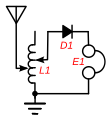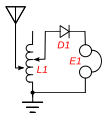
Size of this PNG preview of this SVG file: 382 × 417 pixels. Other resolutions: 220 × 240 pixels | 440 × 480 pixels | 703 × 768 pixels | 938 × 1,024 pixels | 1,876 × 2,048 pixels.
Original file (SVG file, nominally 382 × 417 pixels, file size: 18 KB)
File history
Click on a date/time to view the file as it appeared at that time.
| Date/Time | Thumbnail | Dimensions | User | Comment | |
|---|---|---|---|---|---|
| current | 04:09, 9 May 2017 |  | 382 × 417 (18 KB) | Chetvorno | Replaced with "plain SVG" version which passes validation |
| 02:22, 28 January 2016 |  | 382 × 417 (24 KB) | Chetvorno | Increased line width and tweaked location of components | |
| 07:34, 20 May 2010 |  | 384 × 424 (24 KB) | Chetvorno | {{Information |Description={{en|Circuit of a "two-slider" Wikipedia:crystal radio receiver, a common circuit used in simple crystal radios made before 1920. To tune in different stations, it used a tuning coil ''L1'' with two sliding contacts on it. |
File usage
The following pages on the English Wikipedia use this file (pages on other projects are not listed):
Global file usage
The following other wikis use this file:
- Usage on es.wikipedia.org
